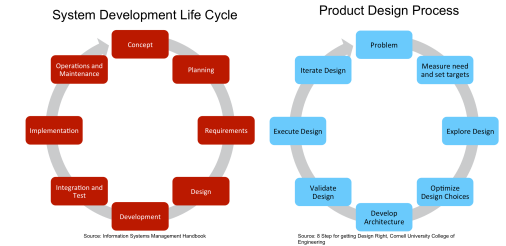As products evolve to contain more and more digital components, the skills, experiences and best practices of IT become crucial for success of product development in a digital world. by Patrick Meehan and Tomas Nielsen
Owning the Digital Future
I remember when this IBM commercial first came out in mid 2000’s. I was very excited about how technology would change everyday life forever. Unfortunately, RFID required large investment in infrastructure and couldn’t connect products with customers from end to end. And so it failed to complete its true promise of connectivity. Majority of the retailers could not invest in the technology at the scale required. Instead RFID became an instrument of back room inventory and logistics management along with improved operational efficiencies on manufacturing floor. But it did not deliver the promise of “The Future Market”.
The good news is that today many companies are re-creating “The Future Market” with their own products. Once again, a new generation of inventors are building a world where products can talk to people through phones, websites and connect throughout the lifecycle. This time digital products or digital components are being developed by both grassroots inventors and product teams in large enterprises everywhere. Finally, the promise of “Digital Future” has value that is driving action and engagement.
Now is the time for CIOs to re-evaluate how IT can add value to the product portfolio by enabling digital products and components to create strategic, long term benefits for customers and company.
Why
Driving Strategy
CIOs have an opportunity to drive business strategy by building functional products that will generate revenue, brand value, customer experience, and valuable customer data. Objectives may vary based on industry, regulatory environment, customer needs, etc. But enabling a digital product is a long-term business strategy that can help grow value for customer and company.
CIOs and IT have tech knowledge and methodologies that are indispensable for long term evolution of the company’s product portfolio. The processes for System Development Life Cycle (SDLC) and Product Design are similar in that the competency can be easily transferred from one to the other. (Source: Gartner, 2014)
The most important gap that exists between IT and New Product Development is business strategy. The business strategy for new products can include understanding target customer, product lifecycle relative to target market, having a measure of market size, pricing, sales, marketing and customer experience just to name a few. Having an understanding of these important product concepts can allow IT to better transition from the tech side to the business side.
Architecture
IT has the competency to integrate digital products with existing platforms within the company to ensure ongoing service management, upgrades, error correction, etc. IT no longer has to be a back room activity that drives a company’s competitive advantage without directly connecting to the customer. They can take initiative to ensure that they own the long term vision of product digitization for the company and integrate systems to create one customer experience, one perspective of customer relationship and one representation of customer activities.
Governance and Strategic Partnerships
CIOs already manage governance of information across the enterprise. Adding digital products to the mix will be like adding a new program to governance portfolio. IT already has the policies, processes, ownership and compliance structure defined and enforced as part of existing governance process for all technologies. Digitized products will simply be an addition to the existing structure with new business owners, policies, processes and compliance reviews. It is important to note that as you change your portfolio, flexibility in governance policies is important. A strategic mindset always aims to explore new options and new ways of accomplishing objectives.
Another important aspect of governance is building strategic partnerships that can enable higher value for the company and customer through digital products. CIOs and IT have long been working with tech partners and have the know-how to start a symbiotic relationship that can be beneficial to both parties. Again, adding another strategic partner is no more work than enabling a new set of business objectives via contractual relationship.
Data Capture and Analytics
The greatest strategic advantage digital products offer is data. CIOs can drive a comprehensive information strategy that can not only continue to inform future product development but also marketing, operations, human capital and future strategies. Data is the core of why products should be digitized. Collecting information about how the customer is using the product, when they are using it, why they are using it is essential to long term digital strategy.
When Nike first got into the data-collection game it stuck sensors to elite athletes running, jumping, spinning and generally doing those impossible things they do. The idea was that the data collected would point Nike designers and engineers toward building better shoes. It did that, but the Nike brain trust understood there was much more the data could unlock”, says Stefan Olander, VP Digital Sport at Nike. “We quickly realized that data can be applied much more broadly,” Olander says. “Why wouldn’t we take all this knowledge, all this innovation and give it back to everyone?” ~ Nike Shoe Sensors Boot Up Performance Data, Michael V. Copeland, CNBC.com.
CIOs can also append product data to other information far more effectively because they own the flow of information from channels, functions and partners. The strategy is to have direct product use data married up to central customers data thus enabling a singular view of the customer from end to end. Analytics can reveal insights about the customer that is both product specific and customer centric.
How
Envisioning Digital Business Model
CIOs should lead the effort to envision a Digital Business Model for their business. The objective of this exercise is to take the traditional business model where technology only automates and improves efficiency of existing processes and “Re-Evolves” it to identify a new value proposition. This exercise will require team members who think in design and work in technology. But instead of thinking one product at a time, the goal is to think in a product portfolio unified with multi-product customer experience. These will be challenging discussions that include such questions as who “owns” the product portfolio, customer information and experience. (Gartner, 2014) Given that IT will lead this discussion the owners of the strategy becomes obvious: Information Technology.
But there is another reason why IT should lead the discussion:
To achieve economies of scale with digital business models requires the development and reuse of digitized platforms across the enterprise. Without such shared platforms, the IT units in companies implement a new solution in response to every business need, creating a spaghetti-like arrangement of systems that do meet specific customer need but are expensive and fragile – and don’t scale enterprise-wide ~ Optimizing Your Digital Business Model, MIT Sloan Management
In order to ensure Digital Business Model is envisioned as a long term strategy, a strategic planning process and roadmap activities are necessary. And creating a Digital Business Model is not only about developing digital products or components but “creating strategic positioning by performing activities differently than rivals do.” ~Michael E. Porter, HBR.org
Nurturing Key Competencies
Beyond envisioning the Digital Future, CIOs should also consider nurturing key competencies required to enable a strategic direction.
Innovation Mindset
There is an absolute need for IT organizations to evolve their culture to an innovation mindset. This battle must be fought by all managers, business and tech, within the company. Every manager knows that “change” of any kind is generally a massive undertaking and the thought of re-thinking, re-building, re-evolving requires a brave heart in IT. Yet, this is exactly what is required when you enter the fray of a Digital Future. The word “No” should no longer be the response to “change”. CIOs must encourage the troops to close this mindset gap first and foremost.
How should this be done? Establish a change management team that creates the necessary momentum and maintains it. One of the failings of strategic effort in IT is that after the initial momentum in driving strategic change, people abandon the battle of managing change. So to enable a long term strategy, the troops must battle on, even when things are looking bleak. And giving change management the authority to help manage the tough times is more important than initially building the momentum for change.
Consulting Team
The consulting layer involves selecting or hiring a team of business consultants who ‘get’ both technology and business functions. These are the ‘sales’ managers and the ‘doers’. CIOs must consider communications with the functions to be the greatest challenge in driving a strategic Digital Future. Gaining the support of key C-Level managers and their subordinates will drive a company wide commitment. Consultants can help manage this communications. Ideally each business consultant would have a speciality and will be the conduit to conversations across the enterprise…both strategic and tactical in nature.
IT Skills Expansion
IT organizations already have many skills that are transferable to new product development platform. But it is always best to ensure that there are no gaps. Some gaps that may need to be filled include a pure corporate strategy, analytics and customer experience competencies. If IT is to lead the long term Digital Future of the company, having these skills within IT will be valuable. Corporate strategy role will help establish the strategic positioning of product portfolio and internal technology from a business perspective. The analytics role will assist in designing and commissioning information necessary to back the strategy. Customer experience acumen will ensure that regardless of the strategy or information, the Digital Future is serving the customers first. With these skills and the current IT organization, CIOs can’t lose in building and collaborating with the business functions to realize the promise of a “Digital Future”.
Kiran Sohi’s career has focused on leading businesses to success by enabling strategic decision making. While my passion is strategy and technology, my work spans a number of corporate disciplines including marketing, finance and operations.
OPEN WRX Consulting Inc. is committed to helping companies improve competitiveness through effective decision making. Services include structuring, facilitating and implementing strategic planning process and strategic solutions for businesses, functional departments and/or channels.
Visit openwrxconsulting.com for more info.





